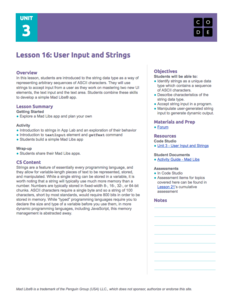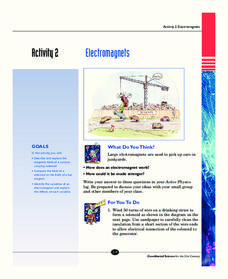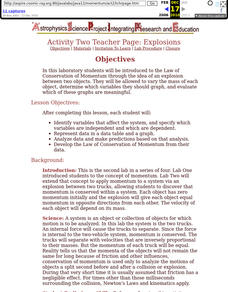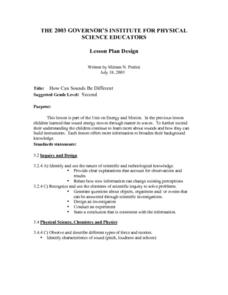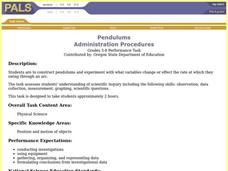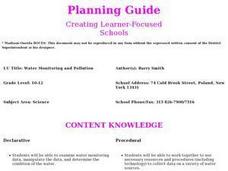National Security Agency
Equations and Expressions
Learners demonstrate their knowledge pictorially, concretely, and abstractly in this unit meant to last three hours over three days. Using hands-on activities, manipulatives, real-world applications, and problem...
Curated OER
Commotion About Motion
Second graders are introduced to different types of motion. They make rolling spider toys and race them on different surfaces to invsetigate forces and motion. Pupils make glue "spider webs" for their spiders after testing different...
Curated OER
Exploring Expressions
Examine parts of an expression in this algebra lesson. Ninth graders identify the properties of the coefficient and their behavior to the graph. They graph the equation on a TI to see their results.
Code.org
User Input and Strings
Pupils learn to apply strings in computer science. They master two new user interface elements and also use string type data to represent ASCII characters. Finally, individuals create an app for Mad Libs in the eighth lesson of the series.
It's About Time
Electromagnets
Young scientists build their own electromagnet and test it by picking up paperclips. Analysis questions evaluate knowledge at the end of the activity.
Curated OER
Solar Kit Lesson #11 Power Maximum: An Electrical Determination
Students identify and implement methods to standardize testing stations that measure solar panel output power. After collecting electrical ouptut data from several solar panels, they plot the current-voltage and power curves. Students...
Curated OER
Marble Madness
Middle schoolers determine the velocity of a marble rolling down the incline. In this physics lesson, students identify the independent and dependent variables in the experiment. They construct and analyze a graph.
Curated OER
Activity Two Teacher Page: Explosions
Students identify variables that affect the system, and specify which variables are independent and which are dependent.
Curated OER
Epidemiology: Graphing and Analyzing Health Data
Students graph data on fetal and infant mortality rates collected by the Centers for Disease Control and Prevention. They identify trends in the data and propose potential causes for the trends.
Curated OER
Introduction to the Scientific Method
Students designs and conduct a scientific experiment that identifies the problem, distinguishes manipulated, responding and controlled variables, collects, analyzes and communicates data, and makes valid inferences and conclusions.
Curated OER
Survival
Students determine the best material from which to make a jacket to keep the body warm in a cold, dry, windy climate. This task assesses the student's ability to perform an entire investigation. In this question the independent...
Curated OER
What's The Matter?
Fourth graders accurately describe various states of matter, Through experimentation, they change a variable to create a new state of matter. Students record their observations about the way matter is changed and the changes that occur...
Curated OER
Altering a Plant Environment
Learners investigate what a controlled group is by creating an experiment. In this plant growth instructional activity, students identify the different parts of a plant and discuss what is needed for a plant to be successfully...
Curated OER
Using The Scientific Method
Students are given a problem or hypothesis, they can create a relevant experiment using the steps to the scientific method. They collect quantitative and qualitative observations in scientific experiments. Students identify the...
Curated OER
Density and Buoyancy Experimental Design
Pupils must plan, design, and conduct an experiment that answers the scientific question: "Come up with a question that addresses the factors (variables) of the water and its effect on whether an object floats or sinks."
Curated OER
How Can Sounds Be Different
Second graders explore energy and motion. They investigate how sound energy moves in waves. Students explore how sounds are varied and how the instruments that make those sounds are built. They observe sounds being produced and predict...
Curated OER
Build An Island
Students explore erosion. In this science lesson, students build an island and observe the effects of erosion on the island. Students discuss freshwater ecosystems in Hawaii.
Curated OER
Pendulums
Students construct a pendulums and experiment with what variables change or effect the rate at which they swing through an arc. They are assessed on scientific inquiry including the following skills: observation, data collection,...
Curated OER
Shells and Subshells
Students explore how to show evidence of subshells and electron filling on the visual scale. They examine subshell filling and evaluate unknowns based on the atomic emission spectrum. Students design an experiment to identify colors of...
Curated OER
Ramp and Review
Young scholars participate in an activity in which they observe a ball as it rolls down an incline into a cup. They take measurements and use equations that describe the concepts of mechanical energy, work and power, momentum, and...
Curated OER
How Do The Colors of Light Mix?
Students investigate the mixing of light. They form a hypotheses to reason why color changes occur and they write conclusions and ask new questions arising from the investigation. Students identify the primary and complementary colors of...
Curated OER
Life Cycle of the Drosophila Fly
Learners observe the life cycle of the Drosophila fly as well as manipulate large numbers of flies, determine the difference between the sexes, and identify the different stages of the fly's life cycle.
Curated OER
Potential and Kinetic Energy
Sixth graders explore potential and kinetic energy. In this science lesson, 6th graders assume the role of a roller coaster engineer and design a roller coaster. Students use their knowledge of kinetic and potential energy to design a...
Curated OER
Water Monitoring and Pollution
Students explore the effects of pollution on water supply and how to identify safe drinking water. They test different samples of water over regular intervals and analyze the results to see if they are cyclical or represent a growing...





